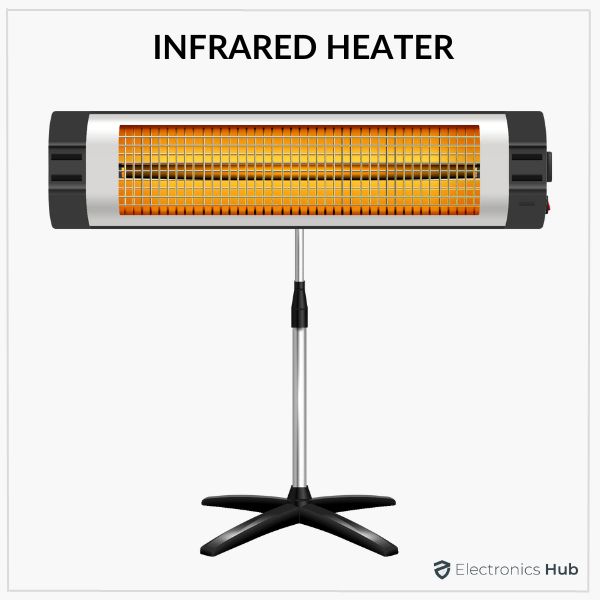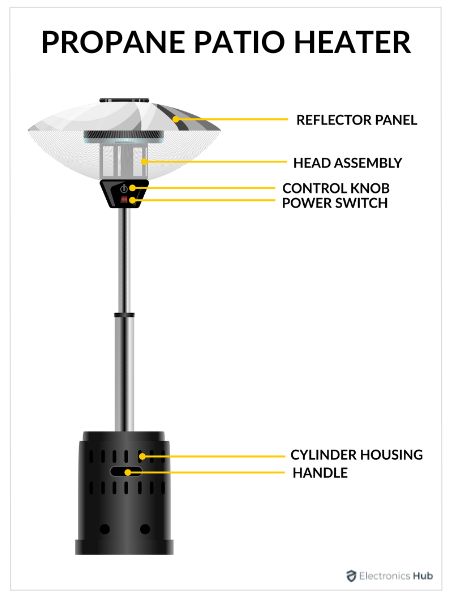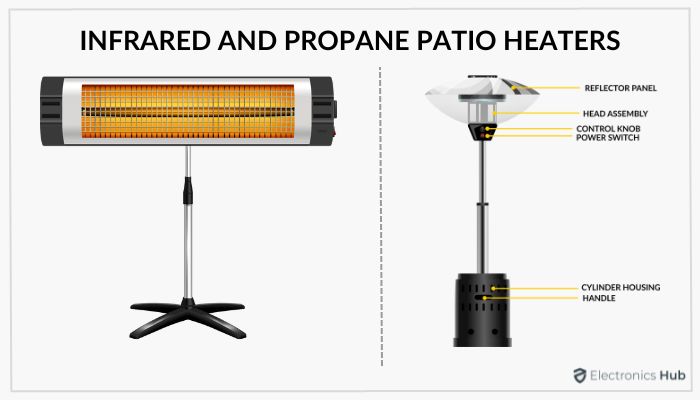When the season changes from fall to winter, temperatures start to drop and people like to stay inside where it is warm and cozy. But what about people who want to have a dinner or family gathering in their garden or patio? Are they stuck indoors on a chilly evening? The answer is no, thanks to Outdoor Heaters. If you are looking to purchase a heater for your porch, patio, or veranda, then you will encounter two primary choices. They are Electric Infrared Heaters and Propane (LPG) Heaters. How do these heaters work? What are the differences between these two? What are their pros and cons? To make a buying decision, you have to understand all these essential things.
In this guide, we will make a detailed Infrared vs Propane Patio Heater comparison. After going through all the details, we hope you will be in a better position to choose the right heater for your “outdoor” heating needs.
Outline
ToggleWhat is an Infrared Heater?

The most common type of infrared heater is the Electric Infrared Heater. In this, the electricity passes through a special heating element. It restricts the flow of electricity and becomes extremely hot and radiates this heat to keep us warm. This process of using electricity to produce heat is known as Joule Heating.
It is clear that the heating element is the main part of Infrared Heaters. We usually use tungsten and nichrome (an alloy of Nickel and Chromium). Basic electric infrared heaters have a ceramic element and the nichrome wire (or tungsten wire) is wrapped around it.
The heat from the sun travels millions of kilometers and provides warmth. It does this without heating the air or vacuum in the path. Infrared Heaters work similarly. They radiate heat without interacting with the surrounding air.
Advantages
- Lightweight and portable
- You can use them anywhere, indoors and outdoors
- Many mounting choices. Place it on the floor or table, wall or ceiling mount
- Very quick heating action. Produces heat within seconds of turning it on
- They are best for direct and spot heating. Suitable for 1 or 2 people
- Zero maintenance. However, a model with blower fans might need some occasional cleaning
- Easy to store during summer. They won’t take up too much storage space
- Doesn’t heat the air but directly radiates heat to our bodies. No dry heat with infrared heaters
- No consumables. Just plug-and-play. You can use the heater for the full life of the heating element
- Fanless models are very quiet. They use just the reflector to radiate the heat. Even models with blower fans have speed adjustments
Disadvantages
- Not suitable for large spaces. Usually, direct or spot heating (in front of the heater or directly under it)
- The heater element, although covered with a mesh, is visible and accessible. Must be careful with kids and pets around infrared heaters
- Apart from radiating heat, infrared heaters also emit hot red visible light. This can be distracting during the night
What is Propane Patio Heater?

When propane comes in contact with oxygen and a spark, the propane gas ignites and starts combustion. This is the principle behind Propane Heaters. They don’t need electricity. Just a tank full of propane and you are ready to go.
Small to medium Propane Heaters are simple devices that contain a tank at the bottom and a burner at the top. Due to this simple design, we often use such heaters in gardens, porches, and patios. Hence, they are often called Propane Patio Heaters.
The Propane Patio heaters are usually floor-standing units. But you can also get them as wall-mounted units. Floor-standing Propane Heaters offer portability. You can easily carry them from one place to other. Or you can keep them in storage during summer or when not in use.
Wall-mounted Propane Heaters are usually a permanent setup where you want year-round heating.
While infrared heaters often come with ratings in watts (for example 700W or 1,500W), Propane Patio Heaters usually have their ratings in British Thermal Units or BTU. So, depending on the area you want to heat, you need to select the appropriate BTU value.
Advantages
- It is eco-friendly. The combustion is clean and produces the least amount of carbon emissions
- You don’t have to rely on electricity. Very useful during power outages, storms, or even emergency situations. Just make sure you have a propane tank handy
- Heating through Propane or LPG is very efficient when compared to electricity
- For the same amount of thermal energy, using propane is much cheaper than electricity
- Usually, most propane heaters come with carbon monoxide detectors that warn us in the event of an unusual amount of carbon monoxide release
- You have multiple mounting options, portable floor standing, and permanent wall or ceiling mount units
- Homes with central heating systems usually use propane heaters. The burner will be in the mechanical room and pipes and vents carry the heat to different parts of the house.
- Propane Patio Heaters can provide warmth in all directions
- They can produce a lot of heat and can easily reach very high temperatures
Disadvantages
- Needs a consumable fuel (Propane). You have to refill the tank or buy additional tanks so that you don’t run out of fuel
- While the carbon emissions are very less, if the combustion is incomplete, it releases carbon monoxide, an odorless and harmful gas. So, you have to be very careful when using propane heaters indoors
- Storing propane is a headache. It is a high-pressure odorless gas that is highly flammable. If there is a leak and you inhale propane (propane poisoning), the effects could be fatal
Difference Between Infrared and Propane Patio Heaters

1. Size and Weight
Electric Infrared Heaters are available in all shapes and sizes. However, whenever we talk about Infrared Heaters, we immediately associate them with small portable units that are lightweight and easy to carry.
Even larger infrared heaters do not weigh that much as the only thing it contains is a heating element and a housing. Some models have blower fans that can help in spreading the heat. These models might be a little heavy.
Outdoor Infrared Heaters are a separate category as they contain long heater elements and you have to mount them on the ceiling (patio or porch ceiling). They can be slightly heavy. So, take all the necessary help.
Propane Patio Heaters on the other hand are usually heavy devices. A typical 45,000 to 50,000 BTU Propane Patio Heater weighs around 40 to 50 lbs. This is of course without propane. They take anywhere between 20 to 30 lbs. of propane. So, the overall weight becomes even more.
2. Design
Infrared Heaters have a generic heater design with either a horizontal or a vertical cuboid shape. The front part has a protective grill and just behind this, you have the main heating element.
Some models, usually Ceramic Heaters, come with blower fans. These models will have an elongated design to house the fans.
Outdoor Infrared Heaters look like long fluorescent tube holders with reflectors. They have multiple rows of the heating element and, in the back, you get a reflector panel to direct the heat downward.
The design of the Propane Patio Heaters is very unique. One common design approach is to have the propane tank at the bottom of the portion that holds the tank. Heaters generally do not come with propane tanks and you have to add a tank separately.
A long stem connects the tank with the burner and is also responsible to carry the propane gas. The bottom part of the burner contains the burner control and the ignition switch.
Covering the burner, you get a hooded shield (the reflector panel) that helps in pushing the heat downwards. As a result, the heat doesn’t escape and can spread up to 9 to 10 feet radially around the heater.
This is just one type of design of the Propane Patio Heater. If you look at catalogs or online listings, you can find several more design options.
3. Portability
Small Infrared Heaters are highly portable devices. Small power infrared heaters (up to 700W) usually don’t have wheels and you can easily carry them from room to room using the handle on top of the unit. If you take slightly larger infrared heaters (1,500W or more), they come with wheels so that you can move them just by pushing them.
Outdoor Infrared Heaters are usually ceiling-mount devices. Once you fix them, there is no need to remove them.
We already know that Propane Patio Heaters are heavy devices. But depending on the style and design, they may or may not come with wheels. Even without wheels, propane heaters are easy to move from one spot to another but make sure to take help. We recommend propane heaters with wheels.
4. Ease of Use
Infrared heaters are simple plug-and-play devices. Just set the position of the heater, insert the power cord into an electrical outlet, and switch on the heater. It is that simple.
Outdoor Infrared Heaters are also very easy to use. As we set up, everything, just flick the switch, and ready to feel the warmth. Some models even come with remote controls.
Things are slightly different when it comes to using a Propane Patio Heater. First, you need to have a propane tank at your disposal as most Propane Heaters do not come with one.
After properly connecting the propane tank, you can place the heater at an optimum position. Then you need to follow a series of steps in a particular order to start the heater. As these steps might not be universal, we highly recommend you read the user manual.
5. Heating Direction
Infrared Heaters are direct and spot heaters i.e., they radiate the heat in one direction (which is usually in front of the heater or just below the heater in the case of a ceiling-mount heater). So, do not expect the heater to cover a wide area.
Propane Patio Heaters can spread heat at 360°. So, if you place it in the center of the patio or porch, you can feel the warmth all around it. However, the radius of this heat spread depends on the capacity of the heater and also the model itself.
6. Efficiency
Infrared heaters in general are less efficient than propane heaters if you compare cost per unit of energy.
7. Fuel/Power
Infrared Heaters, whether indoor or outdoor, use electricity as the main source of power. Other than this there are no fuels or consumables. If you have an electric outlet, you can use an Infrared Heater.
Propane Patio Heaters need propane to burn and produce heat. It is a consumable fuel i.e., as you use it with the burner for combustion, its quantity reduces. Once the tank is empty, you have to refill or replace the tank.
8. Mount Options
Small Infrared Heaters are suitable for indoor as well as outdoor usage. You can place them on floors or tables, mount them on walls or ceilings, or use them anywhere you want.
Outdoor Infrared Heaters are usually large units that are meant to be mounted on the ceiling.
Propane Patio Heaters are outdoor devices. They emit small amounts of carbon monoxide and this can cause problems in closed rooms. But for outdoor usages such as patios, gardens, or porches, you can use place them anywhere as you don’t need to worry about electricity or electrical outlets.
9. Safety
Infrared Heaters are fairly safe devices. But the heating element is exposed even though there is a metal grill preventing access. You have to keep an eye on it when kids or pets are around it.
Outdoor Infrared Heaters, which we mount on the ceiling, are inaccessible to most people. You need to climb a ladder to access it while cleaning.
With Propane Patio Heaters, you need to be very careful as we have a propane tank at the bottom and a burning flame at the top. Most units come with carbon monoxide sensors that alert (or shut off) if they detect excess carbon monoxide.
They also have tip-over protection that shuts off the burner if it detects any tilt of the heater.
10. Maintenance
Infrared Heaters, be they indoor or outdoor units, need no significant maintenance. You may have to occasionally clean the opening. If you chose a unit with blower fans, then you have to clean the fan system from dust.
Propane Patio Heaters need regular maintenance. You have to clean the surface, burner, and reflector. You also have to check the hose for leakages and make sure that the airflow is unobstructed.
11. Cost
Both infrared heaters and propane patio heaters are priced similarly. If you look at a 1,500-Watt Ceiling Mount Infrared Heater, it will cost you anywhere between $100 to $150. Floor Standing units of the same wattage will cost between $100 and $130.
For tall Propane Patio Heaters with 40,000 to 50,000 BTU, you have to spend in the range of $140 to $250. This is only the heater and you need to procure the propane gas in tanks yourself.
Comparison: Infrared vs Propane Patio Heater
Let us now make a simple side-by-side comparison of Infrared vs Propane Patio Heaters for easy understanding.
| Parameter | Infrared Heaters | Propane Patio Heaters |
| Size | Indoor/Outdoor Infrared heaters are small. Ceiling-mount Outdoor Infrared Heaters are slightly large. | They come in several shapes and sizes. |
| Weight | Relatively lightweight | Heavy. With a propane tank, the weight becomes even more |
| Durability | Delicate and needs proper care | Very delicate with exposed burner element and propane tank |
| Power or Fuel | Doesn’t require any consumable fuel. Runs on electricity. | Need propane as fuel which is a consumable |
| Safety | Relatively safe. Must be careful with kids and pets around it. | Must use with extreme caution. Propane is highly inflammable. Shouldn’t tilt or tip. Be very careful around the burner. |
| Maintenance | No need for any maintenance. | Needs regular cleaning, and checking of propane tank and hose. |
| Cost | 1500-Watt Ceiling Mount Infrared Heaters cost between $100 to $150. | Propane Patio Heaters with BTU in the range of 40,000 to 50,000 will cost anywhere between $140 to $250 |
Which One to Buy, an Infrared or Propane Patio Heater?
Both Infrared Heaters and Propane Patio Heaters are good outdoor heaters. So, the choice between an Infrared vs Propane Patio Heater will boil down to personal choice.
With small infrared heaters, you can heat your rooms as well as patios as long as you have a capable electric outlet. Ceiling-Mount Outdoor Infrared Heaters are useful if you are looking for a heater only for your patio or porch.
You don’t have to worry about any fuel. Also, if you don’t have a lawn or garden, then this is a simple solution.
Propane Patio Heaters produce more heat than Infrared Heaters. They are also efficient in terms of energy production as well as cost. With propane heaters, you can use them anywhere you like (outdoors) be it your patio, lawn, garden, etc.
But you need to think about refilling the propane tanks very often. Storing Infrared Heaters is very simple. Turn them off, let them cool down, pack them, and store them. Ceiling-mount Infrared Heaters stay there for summer or winter.
Storing propane heaters during summer or off-season is quite a hassle. You need to take proper care while storing the propane tanks as well as the heater unit.
Conclusion
If you are looking at heaters for your patio or porch, then Electric Infrared Heaters and Propane Patio Heaters are the two popular choices.
In this guide, we saw the basics of both these heaters along with their pros and cons. After that, we saw the differences between the Infrared vs Propane Patio Heater by considering some important parameters.
We hope that this guide could help you understand the differences between Infrared and Propane Patio Heaters so that you can make a better buying decision.
If you feel we missed something or want us to add anything, do let us know in the comments section. It will not only help us but also other readers.

